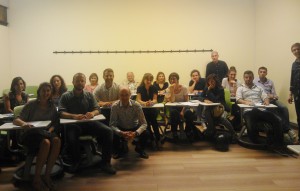People give.
Wherever you are, at whatever time in history, you will see people giving to help others. Poor people give, rich people give, young and old give.
Our role as professionals in fundraising is to mediate the giving, to help people find the cause that best fits their vision of how the world should be. We help people to structure and organise their giving, show how they are making a change to the lives of others, and stand as guarantors for the honesty and impact of our organisations.
That is what is happening in the Middle East and across the Arabic-speaking world. Ancient traditions of personal philanthropy – a cultural norm and a religious requirement – are evolving rapidly thanks to the work of philanthropists, governments and rulers…and fundraisers.
I’m giving a Masterclass with UNHCR’s Reem Abdelhamid on fundraising in the Middle East, at the International Fundraising Congress, 18-21 October, Noordwijkerhout, Netherlands
A LOT OF WORLD
The total population of the Arabic-speaking world – the 22 nations of the League of Arab States – is 392m people (5% of the world’s population), of whom one-third are under 15 years old. Despite the horrors of war and of the forced movements of people – the stuff we see in our news media – the region is developing the social and cultural infrastructures that allow fundraising to evolve; education, taxation, financial systems, the legal and fiscal formalisation of charities and foundations, and personal wealth.
Fundraisers get a rush of blood to the head at the phrase ‘personal wealth.’ We have stereotype pictures of fabulously rich individuals dropping millions into the hands of eager fundraisers in Europe’s leading universities and museums. But that is only a small part of the story. Because personal wealth is spreading outward into a growing middle class, who are becoming the day-to-day donors of national and international organisations.
WHAT NOT TO DO
This is the third consecutive year when we have had IFC workshops or Masterclasses on fundraising in the Arabic-speaking world. Each time, we have learned a little more about how to operate in the region – and what not to do.
NOT A CASH MACHINE
Reem Abdelhamid, UNHCR Advisor for Private Sector Partnerships in the Kingdom of Saudi Arabia, warned early in the series that the region is not a cash-machine. No-one should be planning to hit the streets of Jeddah or Dubai, raise lots of money, and head off.
As UNHCR and other INGOs have found, the Arabic-speaking world requires – just like any other region – careful research, planning, long-term investment and clear links between the donor and the social or environmental problem they are solving.
IT’S NOT ONE PLACE
You would not treat Europe, Latin America, or Asia as one homogeneous region. The same is true of the Arabic-speaking world, where the fundraising that you might do in Kuwait is different from that you would do in Egypt. In part this is because a significant part of the region is a historic area of transit between Europe and Asia – so there are different mixtures of cultures, religions, languages, and thus of philanthropy in different states, and even in different cities. To get a clearer idea of the variation across the region, read the publications from The John D. Gerhart Center for Philanthropy & Civic Engagement at the American University of Cairo.
THINK LOCAL
To make sense of the region you are going to need local help. Houssam Chahin, who has years of experience in the region first with Greenpeace then with UNHCR, stresses the importance of recruiting and developing local teams. This is no different from opening a branch in Germany or Japan; you need people who not only speak the language but who understand the culture and know the market. People who know why this Sheikha is important, and who understand why she might not want to meet you but would meet a female colleague instead. People who can cope with the contradictions that emerge in any developing market, and who can help your organisation steer its way around the legal restrictions that may appear.
POLICY MATCH
In Western Europe we are used to the idea that NGOs challenge governments – campaigning for freedoms, rights and the environment. You are not going to get a warm welcome if you enter the Arabic-speaking region on a campaign ticket. Just reverse the situation and imagine a Kuwaiti foundation opening an office in Europe to campaign against – to pick a ridiculous example – vegetarianism, and you will see why. The developing states of the region have national plans and priorities, and philanthropy, especially strategic philanthropy or ‘major donors’ is often aligned to these priorities, so your fundraising is going to be aligned that way too.
COME AND FIND OUT MORE
The Arabic-speaking world and within that, the Middle East, is a fascinating, fast-changing, challenging environment for fundraising, with huge potential. Come and join Reem Abdelhamid and me for our Masterclass on ‘Fundraising in the Middle East: How, Why and What?’ at IFC 2016, or one of our workshops that will focus on key issues in fundraising in the region.
But do it now; there are only two places left on the Masterclass!
Follow us on Twitter:


